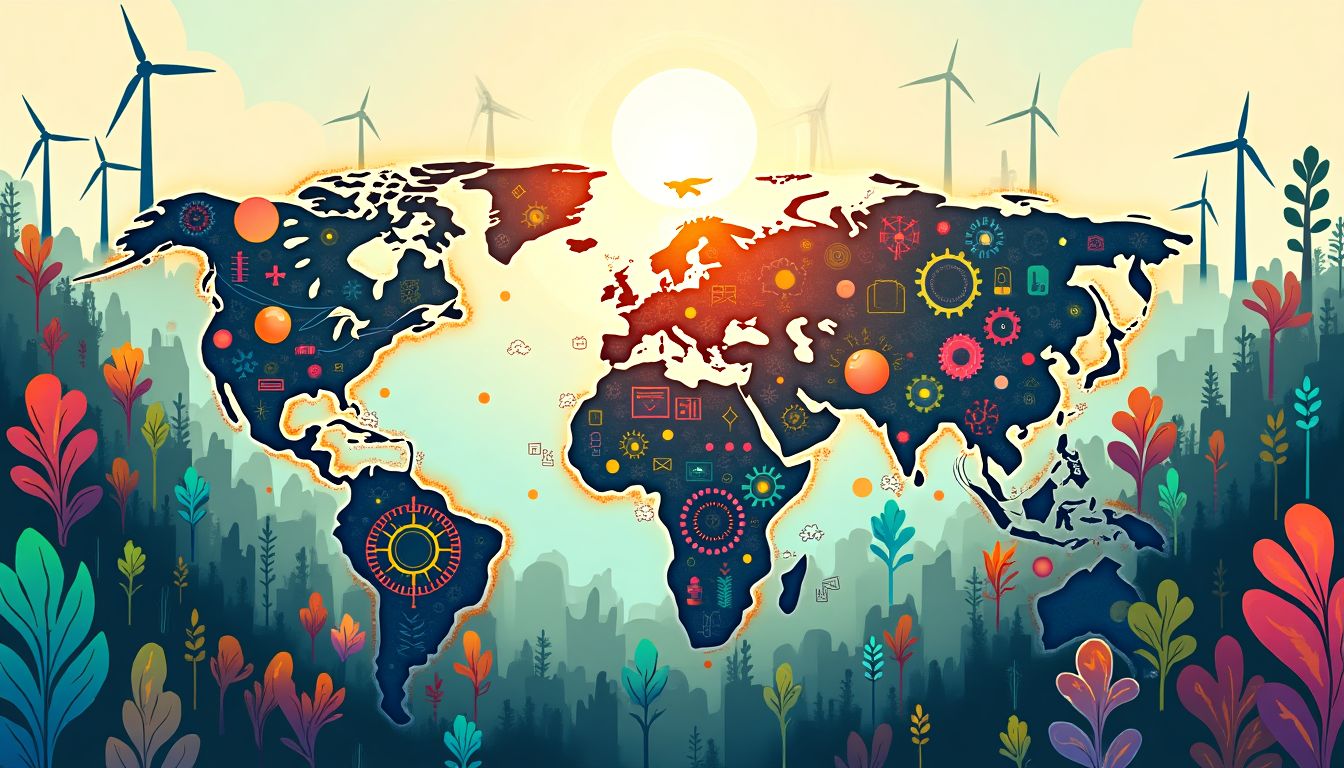In the next decade, rising global temperatures could displace over 200 million people, unleashing a cascade of social, economic, and environmental upheavals the world isn't prepared for. But what if the solution isn’t buried in endless policy debates or Herculean economic sacrifices, but instead harnesses the raw power of machine intelligence? This isn’t just science fiction—it’s the promising intersection of artificial intelligence (AI) and climate justice, the bold notion that technology can pave the way for a fairer, greener world. Luminaries like Kate Raworth, known for her groundbreaking work in sustainable economics; Dr. Fei-Fei Li, a leading AI visionary; and Bill McKibben, the environmental activist and founder of 350.org, have all underscored the critical importance of rethinking how we approach the climate crisis—and AI’s role in it. It’s not just about technology solving problems; it’s about technology amplifying justice.
Climate justice, for those unfamiliar, reframes climate change as more than just reducing carbon emissions. It’s a framework that highlights the unequal burdens borne by historically marginalized communities—whether it’s low-income coastal cities threatened by catastrophic storms or indigenous groups whose livelihoods are tied to vanishing ecosystems. Now, fold into that seemingly insurmountable problem a tool as powerful as AI. What does it look like? To start, imagine an AI algorithm capable of predicting extreme hurricanes weeks in advance, mapping the safest evacuation routes in real time, and ensuring resources are distributed to the hardest-hit areas first. AI offers precision where human systems fail, but it also forces us to ask hard questions: Who benefits most from this technology? And how is it shared or controlled?
In this article, we’ll explore how artificial intelligence can optimize resources, predict and adapt to natural disasters, and create equitable solutions to climate change—all rooted in the principles of justice. By understanding the why, the how, and the who, we’ll uncover how AI can not only help bend the arc of human progress toward sustainability but also equality.
1.1 Understanding Climate Justice
Climate justice isn’t a feel-good buzzword; it’s a paradigm shift in how we address the climate crisis. Essentially, it recognizes that the impacts of climate change are not distributed equally. For instance, while developed nations have historically contributed the most to carbon emissions, it’s the poorer nations and marginalized groups—such as the pacific islanders of Tuvalu or farmworkers in drought-stricken California—who pay the highest price in terms of floods, rising seas, and failing crops. As Naomi Klein has argued in her powerful writings, climate change is deeply entangled with inequality and colonial histories. Addressing one means addressing the other.
Consider this: When coastal cities like New Orleans are hit by hurricanes such as Katrina, it is predominantly low-income communities that face the brunt of housing destruction and prolonged recoveries. Climate justice argues that solutions can’t just focus on preventing the problem; they must also prioritize protecting the most vulnerable and historically underserved populations. This is where AI’s ability to collect and analyze vast datasets comes in. Imagine tools that can highlight the most climate-vulnerable populations on a global scale or customize interventions down to neighborhoods in cities like Mumbai or Lagos, ensuring everyone’s voice matters—not just those who can afford to shout the loudest.
1.2 Why Technology and Equity Need to Be Paired
Despite decades of warnings, traditional approaches to solving climate change—like international treaties or carbon taxes—have fallen painfully short in addressing the lived realities of the marginalized. For example, while renewable energy resources like solar and wind have become more accessible in wealthy countries, entire regions across the Global South are still struggling to even electrify. AI offers us an opportunity to change that narrative. Think about this: By analyzing energy needs and optimizing renewable grids, AI-driven projects could bring green energy to the 759 million people worldwide who currently live without electricity, according to International Energy Agency data.
Pairing cutting-edge technology with human-centered priorities shifts the balance. It’s no longer about trickle-down benefits, like improved solar panels that only the rich can buy. It’s about flipping the narrative to ensure that benefits are built from the ground up. AI can do that—but only if we’re intentional about equity and inclusivity from day one. Without that intentionality, we risk repeating old mistakes, letting the Global North monopolize innovations while the Global South struggles to survive.
1.3 Why AI is Uniquely Suited for This Challenge
So, why AI? What makes it uniquely qualified to wrestle with something as sprawling and intricate as climate justice? AI thrives at finding patterns humans can’t. Whether it’s predicting monsoons in India a week earlier than otherwise possible or optimizing irrigation schedules for Kenyan farmers, AI can turn overwhelming global chaos into actionable local insights. A prime example of AI’s superpower lies in real-time predictive modeling. Tools like IBM’s Weather Insights Platform are already being used to forecast extreme weather with pinpoint accuracy. Now imagine expanding that to predict crop failures months in advance or monitoring deforestation minute by minute via satellite data in the Amazon. AI doesn’t just observe—it anticipates, enabling proactive mitigation rather than reactive despair.
At its best, artificial intelligence combines speed, scalablity, and accuracy that human systems simply can’t rival. But here’s the catch: Making these tools accessible to the communities who need them most is where the rubber meets the road. Platforms like Google’s Earth Engine, which democratize geo-spatial climate data, offer a glimpse of what’s possible when we prioritize inclusivity. The question is: Will AI be a shared resource that lifts all boats, or another technological wave that deepens divides?
2. The Evolution of AI for Resource Optimization in Climate Solutions
2.1 Historical Use of Technology in Climate Work
Let’s rewind a few decades to when technology first became a tool in understanding and fighting climate change. Remember when NASA started using satellite images in the 1970s to measure Earth’s temperature? Those grainy images were the first seeds of a data revolution. Fast forward, and today’s tools like climate simulation software and carbon calculators are leaps ahead, helping scientists track every nuance of our planet. Think of this evolution as going from building sandcastles to designing skyscrapers. It’s a massive leap.
Some hallmark breakthroughs include renewable energy innovations like solar tech modeling developed by research hubs such as MIT. These tools became lifelines across the world, but they're far from perfect. For instance, early detection algorithms for wildfires often lacked coverage in remote areas, leaving gaps in their ability to protect vulnerable communities. While promising, the scope of such tech was inherently limited without the vast capabilities of artificial intelligence.
2.2 Machine Learning and Big Data in Climate Science
Now let’s talk about a serious game-changer: artificial intelligence powered by machine learning. Big data is what makes today's AI tools unbeatable. For instance, AI can analyze mountains of meteorological data to predict severe weather events weeks in advance. Companies like DeepMind have partnered with meteorologists to create systems that forecast floods, heat waves, and hurricanes with unmatched accuracy. Imagine knowing exactly where a hurricane will strike a week early—what a difference that makes for evacuations and disaster prep.
Another fantastic implementation of AI is in forest monitoring, where satellite-based systems powered by algorithms can detect illegal deforestation patterns. Organizations like Global Forest Watch are good examples of this. Such systems combine data from thousands of sources to pinpoint where intervention is most critical.
Energy grids are another area where AI flexes its muscles. AI optimizes power distribution by analyzing usage trends to prevent wastage and reduce strain during peak energy hours. These advancements don’t just reduce emissions; they help save money too. Think of AI as the ultimate energy accountant, leaving no watt unaccounted for.
2.3 Challenges Facing AI Deployment in Climate Work
Of course, it's not all sunshine and rainbows. Implementing AI in the real world comes with heavy baggage. For starters, accessibility—or the lack of it—is a major hurdle. Many countries struggling with climate impacts lack the infrastructure for AI integration. For instance, rural regions in Africa desperately need the benefits AI tools can provide, but there’s often not enough investment to go around.
Then there's the thorny issue of ethics. AI is only as good as the data it's fed. If the data has blind spots (e.g., underrepresenting low-income areas), the results can perpetuate unequal solutions. The tech sector and governments urgently need frameworks to ensure inclusivity and mitigate bias.
Weighing costs versus benefits is another challenge. AI systems require investment upfront, and this might deter financially strapped governments from going all in. Yet, ignoring AI is like refusing free navigation directions on a treacherous road trip—it’s more dangerous in the long run. Balance isn’t easy, but it’s necessary.
3. Key AI-Driven Innovations for Climate Mitigation
3.1 Energy Sector Transformation
If carbon neutrality had a middle name, AI would fit right in. In the energy sector, the transition toward greener grids depends heavily on AI-driven innovations. For starters, smart grids are revolutionizing how we use and save power. Think about it: these grids learn from user habits and predict energy demands. For instance, when Google's DeepMind cut cooling costs in its data centers by 40%, it wasn’t magic—it was AI doing what it does best, optimizing resources to be lean and mean.
Some cities are already exploring these opportunities with AI-enabled renewable energy grids. By balancing solar, wind, and hydro resources, AI can ensure power availability even in tough conditions. For example, cities like Copenhagen have begun integrating AI systems into their energy management strategies to become net-zero carbon pioneers.
3.2 Agriculture and Land Use
Let’s shift gears and imagine a farmer in a drought-ridden region. AI’s role here? Precision agriculture, where every drop of water and sprinkle of fertilizer is calculated for maximum yield. Innovators like John Deere are turning tractors into high-tech machines capable of analyzing soil conditions and forecasting crop needs down to the square inch.
Satellite-powered AI systems also vigilantly monitor deforestation, identifying illegal logging hotspots. NGOs like World Wildlife Fund rely on AI-driven maps for protecting natural habitats. In Indonesia, these tools have been deployed to save rainforests and ensure indigenous land rights are respected.
On the flip side, land misuse and monocropping practices continue to be risks, reminding us to deploy AI thoughtfully and inclusively. But when done right, it’s like giving Earth a digital defense system against exploitation and inefficiency.
3.3 Waste Management and Circular Economies
Humanity generates more than 2 billion tons of waste annually, and a shocking amount ends up in dumps rather than recycling programs. Enter AI, the recycling robot's brain. Systems like those developed by Sortera Alloys use machine vision and robotics to differentiate between recyclable materials faster than any human hand could.
But AI doesn’t stop there—it’s equally involved in creating "circular economies." What does that mean? Essentially, AI models products and materials to be reused again and again, reducing the need for new raw resources. Companies like Climeworks have been busy innovating ways to integrate AI into carbon capture systems, ensuring the CO2 cycle remains closed and clean.
By automating waste separation and encouraging the reuse of materials, AI transforms waste into an economic asset, not an environmental liability. It’s the ultimate win-win for the planet and production lines.
4. Ethical Implications and Inclusion in AI Solutions
4.1 Avoiding Algorithmic Bias
Artificial intelligence isn't flawless. In fact, its potential pitfalls are stark reminders of why ethical considerations matter. AI systems are only as good as the data they're trained on, and data is often riddled with bias. Consider this: if climate-related datasets disproportionately represent wealthier nations, AI-driven solutions might favor those regions while neglecting vulnerable communities in developing countries. Algorithmic bias isn't just a theoretical issue—it has very real consequences.
One glaring example? Algorithmically designed disaster response tools often allocate resources primarily to areas with better infrastructure or wealthier demographics. This leaves marginalized and poorer communities, who are already the most at risk during disasters like hurricanes or wildfires, scrambling for help. Imagine an AI system prioritizing rebuilding efforts in affluent neighborhoods while ignoring villages being swallowed by rising seas. It’s a troubling scenario that demands vigilance and adjustment.
4.2 Inclusivity in Data and Decision-Making
AI solutions can't be truly global without diverse inputs. Who controls the AI matters just as much as what it can do. That’s why including voices from the Global South, indigenous communities, and other marginalized groups is essential. If these groups are left out, AI risks becoming another tool of economic and social oppression rather than a lever for climate justice.
Organizations like Climate Justice Alliance emphasize equity in environmental solutions, but this philosophy needs stronger echoes in tech. Open-access AI platforms are promising solutions, allowing grassroots movements to access resources they wouldn’t otherwise afford. For instance, democratically designed platforms allow non-specialists to collaborate and share localized data to shape AI outcomes better suited to their specific scenarios.
4.3 Building Frameworks for Ethical AI
The million-dollar question: how can we ensure AI works for everyone, not just for the few? One pathway involves global cooperation and ethical frameworks enforced by credible organizations. Think of groups like the United Nations or the World Economic Forum spearheading discussions to solidify guidelines.
Proposed policies could include:
- Mandated transparency in AI algorithms: Demystify how decisions are made.
- Audits by third-party experts: Evaluate fairness and inclusivity.
- Penalties for bias: Introduce measurable accountability mechanisms.
- Open data initiatives: Share climate datasets universally to prevent monopolization by wealthy nations or corporations.
We already see some strides in responsible AI development. For example, the Responsible AI Principles by Google lay groundwork for mitigating risks while advancing innovation. However, achieving true inclusivity will require stronger collective action and streamlined ethical frameworks.
5. Global Collaboration for an AI-Driven Climate Agenda
5.1 Cross-Border Collaboration and Funding
AI knows no borders, and neither does climate change. That's why global-scale problems demand collaborative, international efforts. Cross-border initiatives have already set a precedent. Consider the annual COP summits, which unite countries to tackle climate goals. A similar structure could be adapted to focus specifically on integrating AI into climate mitigation techniques.
Funding is the cornerstone of global AI solutions. Governments, NGOs, and private industry must pool resources to democratize access to AI tools. Imagine this: a universal AI fund created using a carbon taxation model where high-emission industries contribute to deploy AI tools specifically in underdeveloped regions. Not just a pipe dream—this is the type of action model we need to level the playing field.
5.2 Role of Private Sector and Startups
The private sector has a golden opportunity to lead innovation and close funding gaps. Tech titans like Google already leverage AI efficiently—for example, their DeepMind cooling systems slash data center energy usage by nearly 30%. What if that same technology were applied to optimize millions of buildings globally?
Startups, too, are pushing boundaries. Companies like Climeworks, a leader in direct air capture technology, use AI algorithms to improve carbon capture efficiency. Meanwhile, Jupiter Intelligence helps businesses predict and prepare for climate disasters with AI-driven risk models. These small-scale breakthroughs could see monumental impact with the right backing.
5.3 Role of Academia and Nonprofits
Let’s not forget the unsung heroes: researchers and nonprofits. Universities like MIT and Oxford University lead AI-climate research, publishing accessible findings that nonprofits can use to implement community-based solutions. The partnership between research institutions and grassroots nonprofits often fills the gaps that government entities neglect.
One standout example is ClimateAI. Working at the intersection of science and technology, they provide tools for climate resilience, from predictive agricultural planning to urban heat mapping. Building an interdisciplinary bridge across academia, startups, and nonprofits is the key to scaling ideas efficiently without losing focus on equity.
Here’s a quick overview of how different sectors can collaborate:
| Sector | Contribution |
|---|---|
| Private Sector | Funding, scaling innovative AI projects (e.g., Google’s DeepMind). |
| Academia | Core research and AI model advancements. |
| NGOs | Local implementation, advocacy for ethical inclusivity. |
| Governments | Create infrastructure and enforce regulations for equitable AI use. |
Blending these contributions into a unified global framework opens up extraordinary possibilities for achieving climate justice and sustainable development driven by technology.
6. AI Solutions: How Would AI Tackle This Problem?
6.1 Mapping Vulnerabilities with AI
Imagine a world where we can anticipate threats before they strike—whether it’s a devastating cyclone, a choking wildfire, or a famine-inducing drought. AI makes such foresight possible. By integrating real-time weather data, satellite imagery, socioeconomic statistics, and infrastructure maps, AI-powered tools like DesInventar can create detailed, real-time climate vulnerability profiles of cities, regions, and entire nations. This data is a lifesaver for NGOs, governments, or disaster-planning teams that need to know where help is most urgently required. For example, AI models deployed in crisis zones in Africa have greatly enhanced the efficiency of relief efforts, as seen in the World Food Programme’s use of predictive analytics to pre-position aid supplies.
Yet, mapping vulnerabilities is not just about reacting to crises. Countries like Bangladesh are already using tools like WRI Aqueduct to monitor water stress levels, helping avoid future catastrophes. What makes this approach invaluable is its inclusivity. Vulnerability maps can incorporate local knowledge, ensuring that marginalized groups—like indigenous populations living in remote ecologies—don’t get overlooked in the calculus of disaster planning.
6.2 Optimizing Energy and Resources
When resources like food, water, and energy are tightly stretched, efficiency isn’t a luxury—it becomes survival itself. AI steps in to streamline this efficiency. Take renewable energy generation: AI models optimize energy grids by predicting demand surges and managing supply dynamics. For example, Google’s DeepMind cut power usage at their data centers by 40% using AI-driven cooling systems—an achievement that could very well scale to hospitals, airports, or any industry-dependent operation. AI acts like a maestro conducting an orchestra, ensuring each element syncs seamlessly to avoid waste.
On a larger scale, AI can pinpoint the ideal locations for wind or solar farms by analyzing geographical and meteorological data. Startups like Planet Labs use AI-enabled Earth observation technologies to boost efficiency in land and energy assessments. Even in agriculture, AI-enhanced irrigation systems reduce water waste by predicting when and where crops most need watering.
6.3 Carbon Capture and Disaster Resilience
When we talk about climate mitigation, carbon capture often steals the spotlight. Companies like Climeworks are revolutionizing how we trap and repurpose carbon emissions. AI can significantly enhance these systems by predicting optimal capture sites and troubleshooting efficiency bottlenecks in real time. Systems don’t just passively “capture”—AI allows them to learn and adapt, improving their output with each iteration.
Disaster resilience is another space where AI thrives. Early warning systems powered by tools like Google Earth Engine now feed real-time data to alert communities of impending floods or landslides. Case in point: NASA has used machine learning to predict wildfires in California, saving the state millions and protecting countless homes.
6.4 AI-Powered Circular Economies
If sustainability is the endgame, then waste isn’t a problem—it’s an opportunity. AI plays a crucial role in circular economies, designing systems where nothing truly goes to waste. For example, robotic systems from Sortera Systems use AI to identify and sort recyclable materials, reducing contamination in processing plants. In parallel, machine learning can simulate product lifecycles, providing companies with insights into improving reusable designs from the outset.
The future of AI in waste management may sound like science fiction, but startups like ABB Robotics are proving otherwise. By combining sorting robots with predictive analytics, we could soon achieve near-zero landfill waste cities. AI doesn’t just clean up the mess; it prevents it from happening altogether.
6.5 Action Schedule / Roadmap
Here’s a step-by-step guide to implementing an AI-driven climate justice initiative:
- Day 0: Register domain: exampleProjectAIClimate.com to serve as a hub for data-sharing, research repositories, and global collaborations.
- Day 1: Host a global virtual meeting with representatives from academia, corporations like OpenAI, NGOs, and policymakers to finalize funding commitments.
- Day 2: Convene in Brussels to designate leadership roles, set milestones, and establish ethical AI deployment guidelines with experts from the United Nations.
- Week 1: Consolidate computer resources through partnerships with companies like Microsoft and Google to develop shared AI platforms for climate data.
- Week 2: Draft a white paper outlining project scope, including specific AI applications and areas of focus (e.g., vulnerability mapping and energy optimization).
- Month 1: Launch pilot projects in climate-affected regions like sub-Saharan Africa (for agricultural resilience testing) and Pacific Island nations (for coastal monitoring).
- Month 2: Secure political backing during high-profile events like the next COP summit, ensuring alignment with global climate goals.
- Month 3: Establish AI laboratories at leading institutions such as MIT and Oxford to iterate and refine technologies.
- Year 1: Deploy scaled AI infrastructure globally with tools shared under Creative Commons licenses to ensure accessibility in the Global South.
- Year 2: Monitor and evaluate outcomes, integrating feedback loops to improve AI systems. Release an annual transparency report to foster continuous trust and collaboration.
A Brave New World with AI and Climate Justice
What if the key to healing our planet wasn’t more bureaucracy but smarter systems? AI is more than a tool—it’s a partnership, a collaborator that aligns human ingenuity with technical precision. By marrying AI with the principles of climate justice, we’re not just building sustainable futures; we’re giving marginalized communities the voice, support, and resilience they’ve always deserved but seldom received.
The solutions discussed—whether they involve mapping vulnerabilities, building circular economies, or optimizing renewable energy systems—are not utopian fantasies. They are tangible, actionable innovations waiting to be scaled across our warming planet. But the success of these efforts hinges on one factor: global cooperation. From the tech giants stationed in Silicon Valley to the indigenous farmers safeguarding Amazonian rainforests, every stakeholder must have a seat at the table.
So, here’s a vision: twenty years from now, families in flood-prone Bangladesh will receive early-warning alerts hours before storms hit. Regions in sub-Saharan Africa will use AI-driven irrigation to cultivate sustainable harvests even in drought conditions. Countries worldwide will operate on grids so efficient that energy waste becomes a relic of the past. AI doesn’t just promise change; it promises hope.
But hope demands action. Are we ready to embrace AI’s potential for climate justice fully? Will we champion equity while looking for efficiency? The future waits for no one—so why should we?
Let your voice be part of this transformative conversation. Comment below, tell us what you think, and join the movement! For more insights like this, subscribe to our newsletter and become permanent residents of iNthacity: the “Shining City on the Web.”
FAQ: Demystifying AI and Climate Justice
What is climate justice, and why does it matter?
Climate justice goes beyond just fighting climate change. It’s about recognizing that the impacts of global warming, like extreme weather or rising sea levels, aren’t felt evenly across the world. Marginalized groups—such as indigenous communities, people in developing countries, and low-income families—are often hit hardest. This concept places fairness and equity at the center of all climate solutions. Learn more from the United Nations about the critical role of equity in tackling climate change.
How can artificial intelligence (AI) help with climate justice?
AI is like a Swiss Army knife for climate challenges. It uses data and algorithms to do things like predict where floods are likely to cause the most damage, help farmers grow crops more efficiently, and reduce waste by identifying recyclable materials. What makes AI unique? It doesn’t just analyze massive amounts of data; it finds patterns and creates smart solutions humans may not even see. For instance, Google uses AI in its data centers to cool servers more efficiently, cutting their carbon footprint dramatically.
What are some real-world examples of AI fighting climate change?
Here are just a few compelling examples of how AI is being used to tackle climate issues:
- DeepMind partnered with energy grids to predict electricity demand and supply, reducing wasted energy.
- AI tools monitor illegal deforestation in the Amazon by analyzing satellite images in real-time. Check out work by platforms like Global Forest Watch for more detail.
- Startups like Climeworks use AI to enhance carbon-capture facilities, pulling harmful CO2 directly from the atmosphere.
Is climate-focused AI accessible to developing nations?
This is a tough question because resources are not evenly distributed. Many tools require infrastructure, funding, and expertise that wealthier nations have. However, there are initiatives such as open-source software and collaborations through organizations like the United Nations Environment Programme (UNEP), which aim to make AI tools more widely available, especially for regions most affected by climate change. Increasingly, partnerships between governments, nonprofits, and private companies are helping bridge these gaps.
What are the ethical concerns of using AI for climate justice?
The power of AI comes with responsibility. If not designed carefully, AI systems can accidentally worsen inequalities. For example, algorithms trained on biased data might prioritize saving infrastructure in wealthier areas during a flood while overlooking poorer regions. Additionally, the question of who owns and controls the data is critical. Big tech firms like Microsoft dominate much of the AI landscape, which means the voices of smaller or marginalized groups may be underrepresented.
What role does AI play in agriculture and food systems?
Agriculture is ground zero for climate impacts, with droughts, floods, and pests threatening global food supplies. AI makes farming smarter and more sustainable. For instance:
- AI-powered drones monitor crops and soil quality, recommending the exact amount of water or fertilizer needed.
- Predictive algorithms can warn farmers about upcoming weather disruptions, reducing crop loss.
- Platforms like PrecisionHawk use machine learning for precision agriculture, optimizing yields while lowering environmental damage.
Does AI have the potential to solve the climate crisis entirely?
AI is a powerful tool, but it’s not a silver bullet. While it can vastly improve how we handle resources, predict disasters, and develop sustainable technologies, human actions—like passing equitable policies, changing consumption habits, and investing in clean energy—are still fundamental. AI can enhance these efforts, but it doesn’t replace the need for systemic change. As renowned climate scientist Katharine Hayhoe puts it, “The greatest solution to climate change begins with all of us.”
Are there companies already leading in climate-focused AI?
Yes! Many companies and organizations are making strides in this field:
- Google: Using AI to optimize energy efficiency in data centers.
- ClimateAI: Predicting climate risks for industries like agriculture and real estate.
- IBM: Deploying AI to improve supply chain sustainability and reduce waste.
How can individuals contribute to AI-driven climate solutions?
Even if you’re not a tech genius, you can still make a difference:
- Support climate advocacy groups promoting AI and sustainable tech policies.
- Push for transparency and ethical guidelines in AI development through local government or online petitions.
- Spread awareness about initiatives like OpenAI working in the climate space.
How can we ensure marginalized voices aren’t excluded from these breakthroughs?
This is one of the biggest hurdles. One solution is to include diverse leadership in AI projects and ensure representation from marginalized groups during the design phase. Organizations like The Solving work to democratize access to AI tools and advocate for open data policies that don’t exclude underprivileged communities. At a local level, engaging with community leaders ensures solutions work for everyone, not just the elite.
Wait! There's more...check out our gripping short story that continues the journey: The Ghost Network
Disclaimer: This article may contain affiliate links. If you click on these links and make a purchase, we may receive a commission at no additional cost to you. Our recommendations and reviews are always independent and objective, aiming to provide you with the best information and resources.
Get Exclusive Stories, Photos, Art & Offers - Subscribe Today!





























1 comment